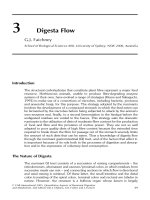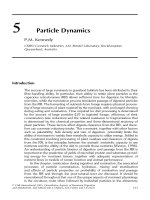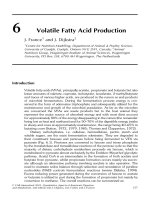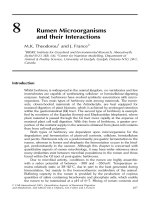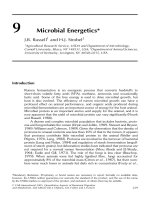Tài liệu Quantitative aspects of ruminant digestion and metabolism - Phần 16 pdf
Bạn đang xem bản rút gọn của tài liệu. Xem và tải ngay bản đầy đủ của tài liệu tại đây (277.63 KB, 32 trang )
21
Lactation: Statistical and Genetic
Aspects of Simulating Lactation
Data from Individual Cows using a
Dynamic, Mechanistic Model of
Dairy Cow Metabolism
H.A. Johnson, T.R. Famula and R.L. Baldwin
Department of Animal Science, University of California, Davis,
CA 95616-8521, USA
Introduction
Empirical models are fitted to experimental data to describe relationships
between dependent and independent variables. By definition, they are best
representations of the input:output data from which they were created. Also by
definition, testing predictions of empirical models against data not used in
formulating the models often leads to failures. Thus, it is generally recognized
that empirical models are only valid for specific situations and do not generalize
because they do not capture underlying reasons for relationships between
dependent and independent variables. In contrast with empirical models, mech-
anistic models are derived from theories about the nature of the system mod-
elled and, as a result, are based upon our understanding of underlying
mechanisms, which drive the system (France and Thornley, 1984; Baldwin,
1995). Also, parameter values in mechanistic equations are derived from
experimental data on each mechanism and, thus, are not derived from statis-
tical analyses of input:output observations on the total system. For example, a
mechanistic model of dairy cow functions would incorporate data on nutrient
uptake, nutrient utilization by tissues, metabolic pathways, enzyme activities,
nutrient concentrations, regulatory systems, etc. while an empirical model
would use data on intake of nutrients and amount of milk or milk components
output and body weight changes. Failure of a mechanistic model to simulate
new, long-term data shows where understanding incorporated into the model
is lacking and what old or new knowledge and experimental data must be
incorporated to further refine and develop the model.
The testing of mechanistic models in biology must consider two perspec-
tives when evaluating the suitability of a computer model to serve as a proxy for
ß CAB International 2005. Quantitative Aspects of Ruminant Digestion
and Metabolism, 2nd edition (eds J. Dijkstra, J.M. Forbes and J. France)
551
physiological processes. The first is a statistical perspective, an evaluation of
the fit of the predictive results of the model to the observed physiological
phenomena. Techniques for such statistical evaluation abound, relying upon
loss functions, likelihood surfaces and measures of ‘goodness-of-fit’ (Diggle
et al., 1994). In addition, investigators are asked to evaluate the statistical
means by which they will draw conclusions, such as the use of computing
algorithms, the parametric form of distributions to consider and the distinction
between classical and Bayesian procedures (Robert and Casella, 1999). The
second form, a biological perspective, concerns the assessment of the behav-
iour of the predictions, whether the estimates of parameters and the ensuing
predictions from such models, make biological ‘sense’. In other words, do
animals, or populations of animals, display the same properties in nature
(in vivo) that the model would have them display ‘in silico’? Our model testing
process must, of needs, consider both. In this chapter, the underlying relation-
ships between diet, intake, milk production and genetic potential to produce
milk represented within a dynamic, mechanistic model of a dairy cow (
MOLLY
)
are examined. First, the main equations representing the metabolic dairy cow
model are described, previous evaluations of the model are presented and
techniques to evaluate models are explained. Second, the sensitivity of the
model to certain parameters used in model evaluation is considered. Finally a
large data set of production data is used to evaluate model predictions.
Overview of
MOLLY
Equations
MOLLY
is the dynamic, mechanistic model of digestion and metabolism of a
lactating dairy cow described in detail by Baldwin (1995) and earlier publica-
tions. The digestion element of the model (Fig. 21.1) is comprised of 15
differential equations descriptive of transactions associated with the state vari-
ables: starch (St), hemicellulose (Hc), cellulose (Ce), soluble carbohydrate (Cs)
equivalents arising from the diet and hydrolysis of insoluble carbohydrates,
microbes (Mi), acetate (Ac), propionate (Pr), butyrate (Bu), insoluble protein
(Pi), amino acids and peptides (Aa), ammonia (Am), ash (soluble as As, insoluble
as Ai), lignin (Lg) and large (Lp) and small feed particles (Sp). Chemical com-
position of the diet is represented by St, Hc, Ce, Lg, Cs (also as Sc), Ac, Pr, Bu,
Pi, Ps (soluble protein), As, Ai, Li (lipid), Oa (organic acids), La (lactate), Pe
(pectin), Nn (non-protein nitrogen), Ur (urea) and fat. Lp and Sp represent
physical attributes of the diet that influence the digestion process. In general,
feed particles pass from the large particle pool to the small particle pool as
digestion proceeds. Passage rates of nutrients associated with feed particles are
influenced by water flow through the digestion process. After hydrolysis and
microbial attachment, the rumen model uses fermentation coefficients to con-
vert starch, soluble carbohydrates and amino acids into volatile fatty acids.
Microbial growth is dependent on pH, ATP, dietary fat, rumen amino acids,
ammonia and particle size.
The animal element of the model (Fig. 21.2) begins with absorbed nutrients
(from Fig. 21.1) and defines transactions associated with ten state variables:
552 H.A. Johnson et al.
Insoluble ash
Ai
Lignin
Lg
Soluble ash
As
Lipid
Li
Starch
St
Organic acids
Oa
Lactate
La
Pectin
Pe
Soluble carbohydrates
Sc
Hemicellulose
Hc
Cellulose
Ce
Insoluble protein
Pi Ps
Acetate
Ac
Soluble protein
Butyrate
BuNn
Non-protein N
FatUr
Urea
Small feed particles (Sp)
with Hc, Ce, Ha, Pi, Ot
Ot Containing
Lg, Ai
Soluble
ash (As)
Saliva
Water (Passage)
Cs, RAa,Am, Fl, As, Mi, RLa, RPr, RBu, RAc
Insoluble protein
(Pi)
Rumen amino
acids
(RAa)
from Ps, Pi, Mi
Saliva
Ammonia
(Am)
Microbes (Mi)
Fermentation
producing
volatile fatty acids
(RAc,RPr, RBu, RLa)
Saliva
Alpha-hexose
(Ha)
Soluble carbohydrates (Cs) from
St, Sc, Ha, Pe, Oa, La, Hc, Ce
Long chain
fatty acids (Fl)
Ce
Hc
Faeces Ot, As, Pi, Hc, Ce, Fl, Mi
Absorbed nutrients
As, Am, RAa (TAbsAa), RAc (AbsAc), RBu (AbsBu),RPr (AbsPr), RLa (AbsRLa), Glucose (AbsGlfrom Cs, La and Mi), Fl (AbsFaand GyGlV)
Large feed particles (Lp) with
Hc, Ce, Ha, Pi, Lg, Ai
Fig. 21.1. Basic flux relationships in the digestive element of the
MOLLY
model. Solid lines indicate digestion processes associated with chemical
characteristics of the diet. Dashed lines represent physical processes associated with digestion.
LactationandDairyCowMetabolismModels553
Total absorbed
amino acids (TAbsAa)
Absorbed
propionic acid (AbsPr)
Absorbed
glucose (AbsGl)
Absorbed
acetate (AbsAc)
Absorbed
fatty acids (AbsFa)
Butyrate
(AbsBu)
Absorbed nutrients
Oxidation
(BuCd)
O
2
CO
2
Plasma total amino acids (TAa)
Made up of His, SAa, Lys, other Aa (Aa)
Body protein
(Pb)
Visceral protein
(Pv)
Ammonia (Am)
Urea
Milk
lactose (Lm)
Protein (Pm) Triacylglyceride (Tm)
Saliva
Pregnancy
(PRG)
Plasma glucose
(Gl)
Oxidation
(PrCd)
O
2
CO
2
Urea
TAaDEG
TAaGlV
PrGlV
Absorbed
lactate (AbsRLa)
Lactate in body
(LaGlB)
Lactate in adipose
(LaGlF)
LaGlV
LaGlV
O
2
CO
2
O
2
CO
2
Lactate in gut
(GGlLa)
GlLmV
Storage triglyceride (Ts)
triose phosphate (TpF), NADPH
2
(HyF),
fatty acids (TsF)
Viscera
triose phosphate (TpV)
NADPH
2
(HyV)
Oxidation
(GlCd)
O
2
CO
2
TAaPm, TAaLAV
Plasma acetate
(Ac)
Oxidation
(AcCd)
O
2
CO
2
Glycerol
(Gy)
GlHyV GlTpV
GyGlV
TAaSal
TAaPbB
TPbAaB
TAaPvV
TPvAaV
TAaPRG
TAaAc
TAaDEG
AcTsF
GlTpF GlHyF
GlLaB
Plasma fatty acids
(Fa)
TsFaF
AcTmV
FaTmV
Oxidation
(FaCd)
O
2
CO
2
Urea
O
2
CO
2
NADPH2
CO
2
NADPH
2
FaTsF
TpTmV
UpGl
Fig. 21.2. Basic flux relationships in the animal element of
MOLLY
. State variables are outlined by heavy black lines.
554H.A.Johnsonetal.
total amino acids (TAa), glucose (Gl), acetate (Ac) and lipids (Fa), body protein
(Pb), visceral protein (Pv), storage triacylglycerol (Ts), milk protein (Pm), milk
lactose (Lm) and milk fat (Tm). Concentration of nutrients in blood is denoted
by a lower case c (i.e. cGl is concentration of glucose in blood, cAc is concen-
tration of acetate in plasma, cTAa is concentration of total amino acids) and is
calculated by dividing the state variable by the distribution volume of glucose.
Inputs into nutrient pools are influenced by absorption of the nutrient from
diet and/or digestion, and conversion from other nutrients or metabolic inter-
mediates by deamination, fermentation or synthetic processes. Outputs from
nutrient pools are oxidation, synthesis of metabolic intermediates, synthesis of
body tissues or secreted products (milk, milk fat, etc.). Algebraic equations are
used in the model to calculate body weights, weight of viscera, weight of body
fat, milk production, excretions, respiratory exchange, energy costs of individ-
ual nutrient transactions, ration metabolizable energy values, total heat produc-
tion, income over feed costs and other outputs. Therefore the model predicts
milk lactose (total volume milk produced), protein and milk fat based on the
metabolic state of the cow, nutrients available to the udder and potential of the
cow to produce milk through the parameters number of udder cells (UCELLS)
and maximal velocities for milk fat and milk protein synthesis. There are also
equations for the demands of pregnancy. To simulate a lactation, diet compos-
ition, daily dry matter intake, initial body weight, body fat per cent (or body
condition score), length of the simulation (days) and UCELLS must be input to
the model.
The original version of
MOLLY
treated amino acids as a single pool. The
model has been rewritten to accommodate four amino acid pools: sulphur
amino acids (SAa), lysine (Lys), histidine (His) and remaining amino acids (Aa).
Equations for the uptake of individual amino acids by mammary tissue (Hanigan
et al., 1992) were incorporated. This revision allows either SAa, Lys, His or
Aa to limit the synthesis of milk (Pm), body (Pb) and visceral (Pv) proteins and
a-lactalbumin and, as a result, lactose synthesis. The stoichiometric parameters,
which define amino acid degradation in the model, have become dynamic
variables dependent on the amount of individual amino acids entering and
leaving the several pools. The sources of entering amino acids are the digestion
of microbial protein, rumen bypass and abomasally infused proteins, amino
acids and degradation of body and visceral proteins. Individual amino acids
leave the pools for the synthesis of milk, body, visceral, salivary, fetal and
placental proteins, and via amino acid degradation. Stoichiometries are calcu-
lated based upon the metabolic pathways for degradation of individual amino
acids. Figure 21.3 shows in detail the equations presented in Fig. 21.2, which
are of primary importance to the discussion presented in this chapter.
Equations for individual transactions such as A to B are mass action (k
Ã
A;
where k is a rate constant in units of per minute, A is amount or concentration
of substrate, B is amount of product, e.g. moles) or Michaelis–Menten form
({v
A
,
B
¼ V
A
,
B
=(1 þ k
A
,
B
=A)}; where v
A
,
B
is velocity of reaction A to B, V
A
,
B
is
maximal velocity of reaction A to B and k
A
,
B
is concentration of substrate A at
which half maximal velocity is reached). For example, a mass action equation in
MOLLY
is UpGl ¼ 0:10
Ã
AbsGl, where the proportion of absorbed glucose,
Lactation and Dairy Cow Metabolism Models 555
AbsGl, going directly to plasma glucose, UpGl is 10%. An example of
a Michaelis–Menten type equation is GlTpF ¼ VGlTpF
Ã
(EBW
0:75
)=(1þ
kGlTpF=cGl), where GlTpF is the velocity of the process glucose to triose
phosphate in adipose (v
A
,
B
), VGlTpF is the maximal velocity of glucose to
triose phosphate in adipose (V
A
,
B
), kGlTpF is the concentration of glucose at
which half the maximal velocity of glucose to triose phosphate is reached (k
A
,
B
)
dAc/dt (mol/day) ¼ absAc þ TAaAc À AcCd À AcTsF À AcTmV
Ac ¼ Total acetate in plasma (mol)
absAc ¼ Acetate absorption (mol/day)
TAaAc ¼ Portion of total amino acids degraded (TAaDEG) that result in the
formation of acetate (mol/day)
AcCd ¼ Acetate oxidation (mol/day)
AcTsF ¼ Acetate to triglyceride synthesis in adipose (mol/day)
AcTmV ¼ Acetate to milk fat synthesis in viscera – mammary (mol/day)
dFa/dt (mol/day) ¼ absFa þ TsFaF À FaCd À FaTsF À FaTmV
Fa ¼ Total fatty acids in plasma (mol)
AbsFa ¼ Fatty acid absorption (mol/day)
TsFaF ¼ Triglyceride breakdown to fatty acids in adipose (mol/day)
FaCd ¼ Fatty acid oxidation (mol/day)
FaTsF ¼ Fatty acids to triglyceride synthesis in adipose (mol/day)
FaTmV ¼ Fatty acids to milk fat synthesis in viscera – mammary (mol/day)
dGl/dt (mol/day) ¼ PrGlV þ UpGl þ TAaGlV þ LaGlV þ GyGlV
À GlLmV À GlHyF À GlTpF À GlLaB À GlHyV À GlTpV À GlCd
Gl ¼ Total glucose in plasma (mol)
PrGlV ¼ Portion of absorbed propionate that results in glucose formation (mol/day)
UpGl ¼ Portion of absorbed glucose that contributes to plasma glucose (mol/day)
(Note: PrGlV þ UpGl ¼ absorbed glucose (absGl)
TAaGlV ¼ Total amino acids going to glucose in viscera – liver (mol/day)
LaGlV ¼ Lactate to glucose in viscera – liver (mol/day)
GyGlV ¼ Glycerol to glucose in viscera – liver (mol/day)
GlLmV¼ Glucose to milk lactose in viscera – mammary (mol/day)
GlHyF ¼ Glucose oxidized via pentose phosphate path for
NADPH production in adipose (mol/day)
GlTpF ¼ Glucose to triose phosphate (glycerol) in adipose (mol/day)
GlLaB ¼ Glucose to lactate in the body – muscle, etc. (mol/day)
GlHyV ¼ Glucose oxidized via pentose phosphate path for
NADPH production in viscera – mammary (mol/day)
GlTpV ¼ Glucose to triose phosphate in viscera – mammary (mol/day)
GlCd ¼ Glucose oxidation (mol/day)
dTAa/dt (mol/day) ¼ TabsAa þ TPbAaB þ TPvAaV
À TAaPbB À TAaPvV À TAaPmV À TAaSAL À TAaDEG À TAaPRG
TAa ¼ Total amino acids in plasma (mol)
TabsAa ¼ Total amino acid absorption (mol/day)
TPbAaB ¼ Protein degradation to total amino acids in the body – muscle (mol/day)
TPvAaV ¼ Protein degradation to total amino acids in viscera (mol/day)
TAaPbB ¼ Total amino acids to protein synthesis – muscle (mol/day)
TAaPvV ¼ Total amino acids to protein synthesis – viscera (mol/day)
TAaPmV ¼ Total amino acids to milk protein synthesis – mammary (mol/day)
TAaSAL ¼ Total amino acids to salivary protein synthesis (mol/day)
TAaDEG ¼ Total amino acids degraded i.e. to glucose and acetate in viscera (mol/day)
TAaPRG ¼ Total amino acids to support fetal growth/pregnancy (mol/day)
Fig. 21.3. Summary and definitions of metabolic transaction equations in
MOLLY
.
556 H.A. Johnson et al.
and cGl is the concentration of circulating glucose (A). The factor (EBW
0:75
) has
been added as a scalar to modify the equation for empty body weight (EBW)
differences between cows and is not included in the classical Michaelis–Menten
equation form.
Previous Evaluations of
MOLLY
Evaluations of the
MOLLY
model have proceeded through several phases. Early
evaluations were qualitative or, at best, semi-quantitative in nature. These
evaluations were directed to the question, are specific equations or systems of
equations adequate in direction and magnitude of responses to perturbations to
allow simulations of reality (Baldwin, 1995). In these tests, the answers were
often no and indicated that our understanding of specific functions was inad-
equate to the simulation of reality. For example, model failures led to experi-
mental studies of factors, which cause variations in rumen microbial growth
rates and yields. These studies led to the identification of amino acids (and later
peptides), microbial maintenance requirements and ammonia availability as
important determinants of growth yields and led to parameterization of equa-
tions to represent these effects (Maeng et al., 1976; Argyle and Baldwin,
1989). Current representations of digestion products and amino acid absorp-
tion from the rumen produced the results depicted in Table 21.1. Cottrill et al.
(1982) fed maize silage-based diets to calves weighing approximately 100 kg.
The simulated data presented in Table 21.1 were produced by resetting the
initial parameters of
MOLLY
to a dry, 100 kg cow. Although
MOLLY
was not
intended to be used to simulate calf data, the magnitude and direction of change
between observed and predicted values in Table 21.1 are similar.
Results of model simulations presented in Table 21.2 agree very well quali-
tatively with those reported by Clark (1975), Polan et al. (1991), Rulquin et al.
(1993) and Whitelaw et al. (1986). In Table 21.2, responses to supplementation
Table 21.1. Simulated responses to urea and fishmeal supplementation of a maize silage-
based diet.
a,b
Diet % CP cAm (mol/l)
AaSI
observed
c
(mol/day)
AaSI
predicted
(mol/day)
MiAa
observed
c
(mol/day)
MiAa
predicted
(mol/day)
Maize silage þ urea 15.0 0.043 3.50 2.76 1.95 2.05
Maize silage þ urea þ
fishmeal
15.0 0.027 4.85 3.32 3.02 2.27
a
CP, crude protein; cAm, rumen concentration of ammonia; AaSI, total amino acids entering the small
intestine; MiAa, microbial amino acids entering the small intestine. In the maize silage þ urea þ fishmeal
diet, 50% of added crude protein was from urea and 50% from fishmeal.
b
Simulations were run for 100 kg calves for 25 days with dry matter intakes of 3.4 and 3.6 kg/day,
respectively. Diets approximated those presented in Cottrill et al. (1982).
c
Observed values are from Cottrill et al. (1982).
Lactation and Dairy Cow Metabolism Models 557
with SAa alone or with Lys alone were relatively minor because both were very
close to limiting (reference diet). As a result, when the concentration of one of
these amino acids in blood was increased by supplementation, the other amino
acid became limiting and effects upon milk (DMILK) and protein (PPM) were
relatively minor. When the availabilities of both SAa and Lys were increased,
milk production increased (5.8% at 84 days) and daily milk protein increased
10%. When a maize-based diet with maize gluten meal as the protein supple-
ment was input into the model, Lys was limiting and supplementation with Lys
resulted in a 7.9% increase in predicted daily milk and an 8.5% increase in daily
milk protein yield at 84 days in milk.
Supplementation of the maize-based diet with Lys and SAa resulted in a
30% increase in milk and protein yields at 84 days in milk. These responses to
SAa and Lys supplementation are higher than those reported by Clark (1975)
and Polan et al. (1991), however the rates of SAa and Lys supplementation
were higher than those used in the cited experiments. Polan et al. (1991)
reported no significant increases in milk and milk protein with rumen protected
methionine supplementation alone (0.11 mol/day) and 7.4% increase in milk
(kg/day) and 2.4% increase in milk protein with rumen protected methionine
(0.11 mol/day) and lysine (0.16 mol/day) supplementation over 22–112 days
in milk. Clark (1975) showed data from two studies with an increase of 3.1% kg
Table 21.2. Effects of base diets and supplements on model outputs
on days 84 and 305 of simulated lactations.
a
At 84 days of lactation After 305 days of lactation
Treatment
DMILK
(kg/day)
PPM
(%)
cTAa
(M Â 10
À3
)
Pm
Lim. Aa
TVMLK
(kg)
TDMIN
(kg)
EBW
(kg)
Reference diet 30.9 3.24 2.2 SAa 7313 5769 636
þ SAa 30.9 3.34 2.1 Lys 7388 5798 637
þ Lys 30.8 3.27 2.2 SAa 7298 5768 636
þ SAa þ Lys 32.7 3.37 1.9 Aa 8235 6028 651
þ Casein 36.0 3.24 2.9 SAa 8507 6079 662
Maize gluten meal 25.4 3.29 2.6 Lys 6492 5551 627
þ SAa 25.4 3.29 2.5 Lys 6504 5556 628
þ Lys 27.4 3.31 2.5 SAa 6854 5651 631
þ SAa þ Lys 33.0 3.37 1.9 Aa 8357 6059 653
þ Casein 33.4 3.31 3.1 SAa 8189 6007 659
a
Values presented are outputs simulated for days 84 and 305 of lactation when a 50% lucerne, 50%
concentrate diet (15% CP) was not supplemented or supplemented with SAa (0.1 mol/day), Lys (0.3 mol/
day), SAa plus Lys or casein (1.9 mol/day) per abomasum. In the second series of runs, maize gluten meal
was the primary protein source with no additional supplement or supplemented with SAa, Lys, SAa plus Lys
or casein per abomasum. The NRC (1989) equation was used to calculate feed intakes for these simula-
tions. Column codes are daily milk yield (DMILK), percentage of protein in milk (PPM), total dry matter
intake (TDMIN), empty body weight (EBW), total concentrations of amino acids (cTAa), the amino acid pool
most limiting to milk protein synthesis (Pm Lim. Aa) and total milk yield (TVMLK). It should be noted that
simulated day 84 values were different when the supplement treatments were simulated beginning on day
70 of lactation rather than beginning the simulation at initiation of lactation due to carryover effects like
those illustrated in Fig. 21.5.
558 H.A. Johnson et al.
milk per day, 6% milk protein and a decrease of 8.1% kg milk per day and
an increase of 1% milk protein in response to methionine supplementation.
With lysine supplementation, milk yield increased 5.9% and 3.3% kg/day and
protein increased 8% and 5%, respectively. Supplementation was over 7 days
and levels of methionine and lysine supplementation were not listed. Rulquin
et al. (1993) developed dose–response curves for lysine and methionine effects
on milk yield. They found very little response to supplementation with increas-
ing amounts of lysine or methionine (less than 1 kg milk per day) and changes
in milk protein ranging between À0.4% to þ 0.1% protein for lysine and
À0.15 to þ0.15 for methionine supplementation.
Responses to abomasal infusion of casein were also greater than those
reported by Whitelaw et al. (1986). With casein infusions of 1.9, 3.7 and
5.6 mol/day for 14 days, milk yield increased 17%, 27% and 32%, respect-
ively. Milk protein increased 3.0%, 4.3% and 5.4%, respectively. Clark (1975)
also summarized data from casein infusion studies in which casein infusions of
2.8, 4.05 and 8.04 mol/day resulted in increases in milk yield of 6.6%, 8.3%
and 12.5% kg/day, respectively. With 2.8 mol casein infused per day, milk
protein also increased 9%.
Additional comparisons of model outputs with detailed data for a 40%
barley diet and a 40% maize diet showed that a large number of model outputs
were within the standard errors (10%) of observed values (Baldwin and Bau-
man, 1984). Experimental studies of adipose tissue metabolism to define and
parameterize improved equations to represent metabolite interactions, the
regulation of lipogenesis, energy storage and lipolysis (Yang and Baldwin,
1973a,b), experimental studies of cow liver metabolism (Knapp et al., 1992),
mammary gland metabolism and nutrient uptake (Miller et al., 1991; Hanigan
et al., 1992; Hanigan and Baldwin, 1994) were undertaken to better define
and parameterize equations for the metabolism of these tissues. Detailed
models of metabolism in adipose tissues (Baldwin, 1995), liver (Freetly et al.,
1993) and mammary glands (Hanigan and Baldwin, 1994) were constructed to
support the formulation and parameterization of aggregated equations incorp-
orated into the cow model. These are also used in formulating changes in
existing cow model equations.
Two quantitative evaluations are presented in Figs 21.4 and 21.5. The
metabolizable energy values of feeds are dependent upon many digestive
and animal functions. Values predicted by the model agree with observed
values, within experimental errors, for a wide range of feeds (ME values of
7.5–13 MJ/kg; Baldwin et al., 1994) with no systematic errors (Fig. 21.4).
Rumen and total tract digestion coefficients for starch, hemicellulose, cellulose
and protein agree closely with observed values (Baldwin, 1995). Several ex-
ceptions to close agreements with data in simulations of digestion have been
reported (Baldwin et al., 1994). The most notable is that rumen starch diges-
tion is significantly overestimated for cracked maize diets (20%) and at high
feed intakes (20–30% at 25 kg feed per day).
Broster and Broster (1984) summarized the results of a comprehensive
series of full lactation studies with cows fed a variety of diets. These studies
defined very significant ‘carryover’ effects after feeding high-energy and
Lactation and Dairy Cow Metabolism Models 559
high-protein diets during early lactation. These observations prompted the
simulation analyses presented in Fig. 21.5. The model responses to low and
high intakes of energy and protein during early lactation were simulated very
well. More importantly, the carryover effects noted by Broster and Broster
(1984) were simulated very well in terms of magnitude and duration.
6.5
7.5
8.5
9.5
10.5
11.5
12.5
13.5
6.5 7.5 8.5 9.5 10.5 11.5 12.5 13.5
Observed ME (MJ/kg)
Predicted ME (MJ/kg)
Fig. 21.4. Comparisons of predicted vs. observed estimates of metabolizable energy (ME).
Regression equation for predicted ME on observed ME with no intercept was y ¼ bx (b ¼ 1.01)
with R
2
values for ME of 0.84. The 34 experimental estimates were from 20 publications in the
literature for diets including high- and low-quality legumes, maize silage, maize meal, soybean
meal and high- and low-quality grass hays (Baldwin et al., 1994).
0
10
20
30
40
50
60
0 50 100 150 200
Days of lactation
Milk yield (kg/day)
HHHH
HHHM
HMHM
HMLM
Fig. 21.5. Effects of different feeding strategies upon lactation performance. Diets were 50%
forage, 50% concentrate with fishmeal added to 15% or 18% crude protein. HHHH was fed 18%
crude protein diet at a feeding rate of 10 kg/day plus 1 kg feed per 3 kg milk for 180 days. HHHM
was fed 18% crude protein diet for 84 days and then fed 15% crude protein diet for the last 96
days. Feeding rate of both diets was 10 kg/day plus 1 kg feed per 3 kg milk averaged over the
previous 3 weeks. HMHM was fed 15% crude protein diet at a feeding rate of 10 kg/day plus 1 kg
feed per 3 kg milk averaged over the previous 3 weeks for 180 days. HMLM was fed 15% crude
protein diet for 180 days. For the first 84 days, feeding rate was 10 kg/day plus 1 kg feed per 3 kg
milk averaged over the previous 3 weeks. For the last 96 days, feeding rate was 13 kg/day plus 1 kg
feed per 3 kg milk averaged over the previous 3 weeks. From Baldwin (1995).
560 H.A. Johnson et al.
The relationship illustrated in Fig. 21.6 indicates that the
MOLLY
model can
simulate the classical effect of changes in the availability of a limiting amino acid
upon rates of degradation of other amino acids. In these simulations, the model
predicted that processes such as milk protein production and body protein
synthesis would be limited by the amount of sulphur amino acids available to
the cow. According to the limiting amino acid theory, as more sulphur (i.e.
limiting) amino acids become available to the cow, use of other amino acids for
protein processes should increase resulting in decreases in degradation of other
amino acids. Figure 21.6 shows that as the absorption of the limiting amino
acids (sulphur amino acids) is increased in sequential simulations, lysine degrad-
ation is decreased due to an increase in lysine use for protein synthesis.
In the course of preliminary tests of
MOLLY
against full lactation data where
individual animal feed intakes were specified as input, an important cumulative
error became evident (Johnson et al., 1999; McNamara and Baldwin, 2000).
This error was a net accumulation of body fat during lactation on several but not
all diets. The errors are relatively small on a daily basis (1–4% of MEI) but the
cumulative error is large; up to 100 kg EBW. When the diets were fed according
to the NRC equations, this accumulation of fat did not occur. This may indicate
errors attributable to overestimates of feed intakes in the several experiments or
the equation. Errors in model predictions of ME for the feeds (0.1–0.2 Mcal/kg)
could be at fault but estimates of diet ME values from tabulated NE
L
values in the
NRC are in close agreement for the experiments simulated. McNamara and
Baldwin (2000) examined the observed and simulated dynamics of lipid metab-
olism and identified some systematic errors in the regulation of adipose tissue
lipogenesis and lipolysis. Modifications have been made in the model and will be
tested. However, these will not correct the problem since if too much energy is
input or not enough output, fat gain is the essential result. Milk energy outputs in
the simulations were essentially as observed. Thus, the remaining source of error
to consider is heat production. Possible errors in estimates of heat production
0.5
0.55
0.6
0.65
0.7
0.75
0.8
0.85
0.3 0.35 0.4 0.45 0.5 0.55 0.6 0.65 0.7
Absorption of sulphur amino acids (mol/day)
Lysine degradation (mol/day)
Fig. 21.6. Simulated effect of sulphur amino acids (SAa) on whole-body degradation of Lys. The
reference diet, containing 50% lucerne hay and 50% concentrate with 15% crude protein, was
supplemented with Lys at 0.3 mol/day.
Lactation and Dairy Cow Metabolism Models 561
attributable to physiological work, protein turnover and ion (nutrient) transport
were mentioned above. Whether or not changes in these are adequately simu-
lated, particularly at high feed intakes, is an issue. Another possibility is that
changes in the relative weights of high vs. low energy requiring tissues during
lactation are not adequately simulated.
Statistical Methods for Model Evaluation
Traditional problems in statistics begin with the design of an experiment, the
collection of relevant data and proceed to methods of parameter estimation and
hypothesis testing. Investigators in these settings build simple-to-understand linear
statistical models, under assumptions of normally distributed random variables,
using analytical techniques like regression and the analysis of variance (McCulloch
and Searle, 2001). These methods permit estimation of unknown parameters,
the variances of these estimates, and accordingly, investigators typically contrast
these parameter estimates in an effort to declare ‘significance’ of effects.
The mechanisticmodel considered inthischapter is of such complexity that we
turn to more computer-intensive strategies to evaluate their effectiveness (Hjorth,
1994). Such methods eventually appeal to bootstrap techniques (Efron, 1979;
Efron and Tibshirani, 1993), a strategy made possible by advances in computer
hardware and software. This technique should become a critical component of
strategies for model validation, selection and the evaluationof parameter estimates
as a complement to the more traditional methods of statistical evaluation.
Error and loss functions
The statistical evaluation of models typically focuses on concern for uncertainty
and error. Generically error can be thought of originating from any of several
categories: uncertainty rooted in limitations of sample size, systematic error as
the result of inadequacies of a statistical model to accommodate effects present
in the data and prediction error, as occurs when predicting observations into
the future when residuals cannot be evaluated. Another form of uncertainty,
often neglected, is model selection uncertainty, that form of error which can
occur when one set of data is evaluated under a variety of models, with one
model selected, under some criterion, as ‘best’. For example, in a regression
model, which predicts milk production from dry matter intake, sample size
limits would be the error associated with number of cows used to represent the
true population mean for milk production. Systematic error is consistent under
or over prediction of milk production by the regression equation and might
be represented by not including diet composition or initial body weight in the
regression equation of milk production on dry matter intake. Prediction error is
the error associated with using dry matter intake to predict the cow’s future milk
production. Model uncertainty is error associated with the prediction of
milk production using several models (milk production regressed on dry matter
intake, milk production regressed on dry matter intake and diet composition, or
MOLLY
) to choose which model predicts milk production the ‘best’.
562 H.A. Johnson et al.

